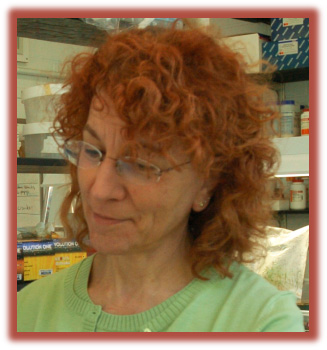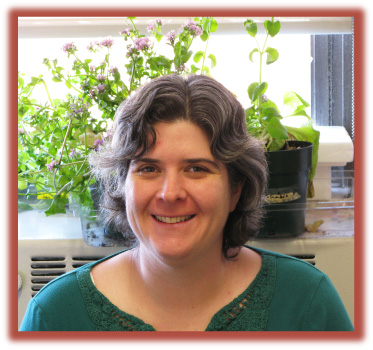Geraldine Boyden (Geri)Botanical Society of America Student ProfilesGraduate Student, St. John's University, 8000 Utopia Parkway, Queens NY
MY BOTANICAL STORY (so far)Most of my early years were spent on the beautiful island of Jamaica, a country surrounded by water and a vast array of some of the world’s most beautiful floras. As a child, I witnessed my grandparents using plants for nutrition as well as medicinal purposes. Some of these uses involved treating common ailments, such as: common colds, flu and other medical issues. During my early years, those encounters marked the extent of my indulgence and interest in plants although most of those applications have been adopted for present day situations. As a young adult, I must admit that I took plants for granted with the exception of those scientifically important ones used as models for basic experiments during my high school years. Besides picking flowers and leaves and preserving them in books during my spare time, some of my laboratory assignments involved basic ecological sampling, which involved the use of quadrats. My major involvement in field studies and botany were minimal and so my interest in plant science was not accentuated until much later, unlike for many botanists. My first significant research experience working with plants was during my senior year as an undergraduate in the laboratory of Dr. Helen Asemota. She is a distinguished faculty member of Biochemistry and Basic Medical Sciences at the University of the West Indies, Mona, Jamaica. The objective of the research was to investigate the effects of salinity stress on selected cell wall enzymes in Dioscorea alata (St. Vincent yams). I was exposed to tissue culture techniques and used standard germination methods to generate seedlings for the research project. Although I had so much fun working on the project and my interest in plant science increased, I still had no plans of pursuing plant related research. Research using plant models came as a coincidence. I applied to graduate schools in 2006 with an objective of obtaining a Master’s degree in Biotechnology. I was encouraged by the presiding chairman then to consider doing the Ph.D. and fortunately, I got accepted into a competitive and rewarding Ph.D. program in the Department of Biology at St. John’s University. When I applied in 2006, plant studies was not available to graduate students, however, the discipline was introduced to the graduate division in 2007 when the university hired a faculty member, Dianella Howarth, Ph.D. She was quite open-minded in directing a number of plant related research projects in her lab. Her lab focuses mainly on evolutionary developmental (evo-devo) studies and phylogenetics with applications to the field of Botany. Owing to all my scientific experiences and serendipitous encounters with plants, I soon became interested in plant related research and became the first graduate student to join the lab. I am currently doing doctoral research in her laboratory, collaborating with Amy Litt, Ph.D. at The New York Botanical Gardens. My research involves the use of the virus-induced gene silencing (VIGS) strategy in studying the role of paralogs of CYCLOIDEA-like genes, in governing the development and floral patterning of Fedia cornucopiae flowers in the Valerianaceae (Dipsacales). As one would imagine, the architecture and petal arrangement in flowers are of great importance in pollination biology and significantly impact angiosperm diversity. Therefore, using the VIGS strategy, a robust functional reverse genetic tool for high throughput analyses, I can obtain relevant information on the role of genes governing floral arrangement. Unique morphological differences in the phenotype in mutants compared to wild-type are identified using Scanning Electron Microscopy. Genes down-regulated in the process are quantified by using Real-Time PCR. This project is tremendously fascinating and I am hoping to adequately understand the interactions of the various paralogs of floral symmetry gene, CYCLOIDEA, in governing floral form. To this end, life has been quite rewarding and I have found plants to be quite fascinating to work with. I consider plant science as a very important entity in biological sciences but much more emphasis could be placed in this area. As we move forwards into the 21st century, one important objective is to develop strategies to introduce concepts and techniques for engaging research using plant models and to find ways of promoting plant science especially to the next generation. Besides learning much about plants, I have had the opportunity to meet some of the most renowned plant scientists who are not only pleasant people but are also very passionate about the field. In addition, some of the opportunities made available to me since I have been working with plants include receiving a number of travel grants, which permitted me to attend a Gordon Research Conference and two Botany conferences (Botany 2010 Providence, RI and Botany 2011, St. Louis, MO) where I presented my work. Those meetings have afforded me some of the best experiences and opportunities during my graduate career; which boosted my interest and confidence in the field and ultimately my efforts in completing my degree. As a member of the Botanical Society of America, I endeavor to make a positive contribution to plant science. Currently, I intend to volunteer as a PlantingScience mentor where I will work with other plant scientists in order to improve scientific literacy and interests among middle and high school students and particularly help them to understand the nature of science (http://www.plantingscience.org/). I also intend to provide services to under-represented college students from socio-economical and disadvantaged backgrounds, specifically helping underrepresented women to identify opportunities and increase interests in science. In addition, I also hope to embark on missions that will positively contribute to improving quality of life and sustainability through plant science. Organizations that are specifically involved in feeding the world through sustainable agriculture are of interest and are one of many priorities on my list.
|
|||||||||||||||||||||||||||||||||||||









